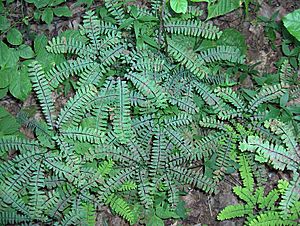Northern maidenhair fern facts for kids
Quick facts for kids Northern maidenhair fern |
|
|---|---|
 |
|
| Northern Maidenhair (Adiantum pedatum) | |
| Conservation status | |
| Scientific classification | |
| Genus: |
Adiantum
|
| Species: |
pedatum
|
| Varieties | |
|
|
| Synonyms | |
|
|
The Northern Maidenhair fern (Adiantum pedatum), also called the five-fingered fern, is a beautiful type of fern. It grows naturally in wet forests across eastern North America. Like other ferns in its group, its name "maidenhair" comes from its thin, shiny black stems, which look a bit like hair.
What Does It Look Like?
The Northern Maidenhair fern can grow quite tall. It usually reaches between 30 to 75 centimeters (about 1 to 2.5 feet) in height. It is a deciduous plant. This means its leaves die back in the fall. New leaves then grow again in the spring, much like many trees do.
How Scientists Name This Fern
The Northern Maidenhair fern was officially named Adiantum pedatum by Carl Linnaeus in 1753. Linnaeus was a famous Swedish scientist. He created the system we use today to name plants and animals. He wrote about this fern in his important book, Species Plantarum.
Scientists sometimes find that what they thought was one species is actually several very similar ones. Over time, some ferns that looked like A. pedatum were given their own names. These include A. aleuticum and A. viridimontanum. These related ferns have fronds (fern leaves) that split into two parts. Their small leaf sections, called pinnae, grow only on one side of the stem.
Where Does It Grow?
This fern can be found in many different places. However, it prefers soils that are rich in humus (decayed plant matter). The soil also needs to be moist but drain well. You can find it growing both in the ground and on rock faces or ledges. It thrives in these spots as long as there is enough moisture.
See also
 In Spanish: Culantrillo de Canadá para niños
In Spanish: Culantrillo de Canadá para niños


